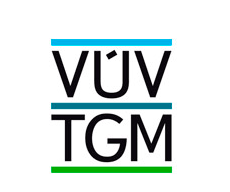History
1919–2017: 98 Years of Research in a Field of Water
Establishment of the Institute
Water Research Institute was one of the first scientific institutes established in the independent republic of Czechs and Slovaks. This priority was the logical consequence of the major attention concerning the water management and treatment our country enjoyed for centuries – from the building of pond systems with a culmination in the 15th and 16th century, followed by projects for improving navigability of large rivers and establishments of observations and measurements in the early 19th century. The establishment of hydrographic services at the end of the 19th century initiated conditions for scientific approaches to water issues. The Institute was the natural successor of these services.
The institute was founded as the State Hydrological Institute by the Ministerial Council Resolution of 19th December 1919. Report of the Council meeting aptly characterizes the reasons that led to the establishment of the Institute: "... Czech engineers in their otherwise excellent and recognized work are dependent only on pure speculation, and lack the access to research and testing institutes, in which their projects and ideas could be tested before presenting them to the public and performing them."
The Institute was founded as the center for hydrological services for the whole territory of Czechoslovakia while hydrographic departments in regional offices in Prague, Brno, Bratislava and Užhorod were established to provide the services in respective regions. The organizational activities were launched, according to the ideological design by Dr. Ing. Jan Smetana, on 13th October 1920 and since 1922 the Institute has focused on its mission – research, which was initially mainly hydrological.
According to the deed of foundation the Institute was about to carry out the activities as follows:
- scientific research of precipitation, surface water and groundwater and their mutual interactions in order to to use the results of this research to solve all issues of an effective and economical water usage and protection against it,
- research of universal laws of water motion in open water channels, pipes and soils,
- experiments, whose purpose is to ensure that water civil engineering works are effectively designed and organized in terms of hydraulic and thus also structural aspects,
- experimental research in a field of groundwater,
- experimental research in a field soil mechanics and earth structures in relation to water,
- experiments in towing objects in water,
- performance tests of water engines,
- experimental research in a field of hydrometry.
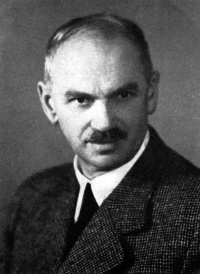
Dr. Ing. Jan Smetana contributed to the foundation of the Insitute
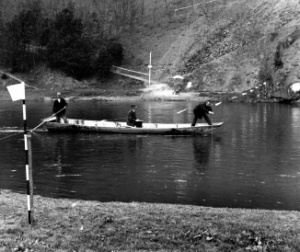
Hydrological measurements in the past
First Years and Construction of Premises in Podbaba
During the first ten years of the existence of the Hydrological Institute, its staff worked in inadequate conditions in locations scattered throughout Prague. The effectiveness of the research activities was limited by these unsatisfactory conditions and therefore an idea of possible building of the Institute in Prague was initiated in 1921. Finally, it was decided that the Institute would be located on large grounds in Prague-Podbaba. The construction started in 1927 according to the final architectural design developed by architect František Bartoš. The first completed structure was the calibration channel (1930) and subsequently building A with hydrotechnical laboratory was completed. At that time, the Institute had 34 employees.
Hydrotechnical problems became more important and therefore the Decision of the Ministry of Public Works of 18th August 1925 approved an establishment of the Hydrotechnical Institute and its fusion with the Hydrological Institute. An additional building B was completed in 1933 and the staff of the Institute could fully focus on its research activities.
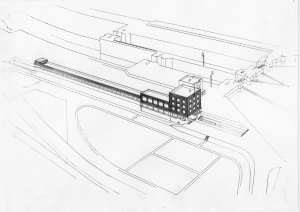
Blueprint of the building A design
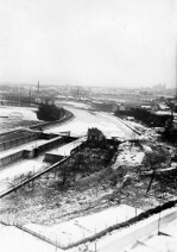
Construction site of the Institute´s premises in Prague-Podbaba
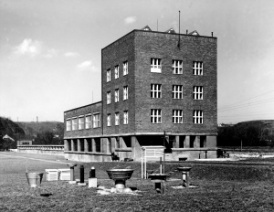
Building A with the calibration channel
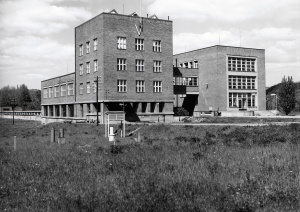
Buildings A and B which were finished in 1933
Institute and T. G. Masaryk
The first President of the Republic was well aware of the importance of science and research for the newly forming state. This is testified by his quote: "The highest performance of an entire nation and state should be based on scientific basis, all of the work should be systematically built on scientific theory." Honour of T. G. Masaryk, respected by the majority of the population of the Republic, was expressed by staff of the Institute in 1930 – in the year the first Czechoslovak President celebrated his 80th birthday – by applying for his agreement to add his name to the official name of the Institute. With the permission of the President of the Republic, the Institute was renamed to the T. G. Masaryk Hydrological and Hydrotechnical State Research Institutes. In 1933, the Institutes were honoured by a visit of the President. In 1946, the name of the Institute, while maintaining the scope and extent of its activities, was simplified to the T. G. Masaryk State Hydrological Institute. Consequently to political changes, the Institute was renamed to the Water Research Institute in 1951 and again in 1990 by returning the name of the first Czechoslovak President.
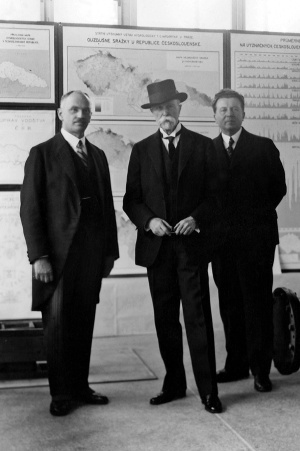
T. G. Masaryk, the first president of Czechoslovakia, visited the Institute in 1933
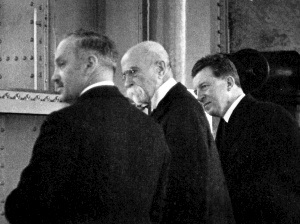
Branches of the Institute
In the forties, the Institute had to cope with the need to comprehensively address the specific water problems caused by industrialization in northern Moravia and Brno town vicinity. The first regional office, which was already established in Ostrava in 1942, focused on problems associated with deteriorating water quality in the Odra River and its tributaries. The staff of the regional office of the Institute in Brno, which was established in 1949, was responsible for water management research and development in the Morava River basin.
In 1951, a regional office was also established in Bratislava. Subsequent development, associated with the process of federalization process and a broadening scope of research activities, initiated the establishment of the Research Institute of Water Management in 1968, which substituted, as an independent institution, the office in Bratislava. Regional offices in Brno and Ostrava obtained the status of branches of the Institute.
The current focus of the regional branches of the Institute is still mainly on regional issues, which can be illustrated by their research projects that involve e.g. identification of anthropogenic pressures on the status of water and aquatic ecosystems in the Morava, Dyje and Odra River basins. In addition, the scope of the research activities is permanently broadened by new challenges, such as the ecotoxicological issues or flood risks in the Czech Republic etc. Due to these facts, new premises of both branches had to be built. New buildings of Ostrava branch were finished in 1997 and Brno branch in 2006, respectively.

Brno branch building
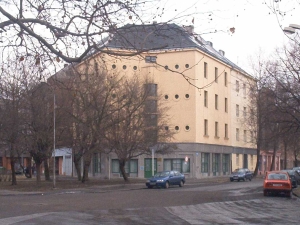
Ostrava branch building
Post-war Development
The post-war development in the water management research was associated with a number of new challenges. After 1945, the Institute extended its research capacities in the areas of water purity and quality, wastewater treatment and water supply and maintained its capacities in hydrology and hydrotechnics. Development in hydropower industry was associated with new research requirements and the Institute initiated construction of the third building, which included hydrotechnic laboratory. The total area of the roofed laboratories increased to 1 840 m2 in addition to the unroofed area of 2 700 m2 In the second half of the fifties the aerodynamic laboratory, which soon became the imoprtant parto of experimental base of the Institute, was built up.
The changes in organization were laid down by the Act No. 261/49 Coll. of 7th December 1949, on Organization of Research and Documentation Services, as amended by the Act No. 185/1950 Coll., which established the Water Research Institute in Prague and its regional branch in Bratislava as a departmental research institute. In the fifties, the hydrological and meteorological services were separated from the research and they were subsequently moved to a newly founded Hydrometeorological Institute. Research on surface water, groundwater and precipitation hydrology remained in the Institute. In addition, department dealing with soil mechanics was removed but the Institute was extended by laboratories for chemical, biological and bacteriological analyses.
In 1969, requirements for integrated studies involving also management and economic aspects initiated the establishment of the Centre for the Development of Water Management, which was incorporated into the structure of the Institute. In 1975, the Centre was integrated with a development group of Water-management Development and Construction company and this new body of the Institute undertook responsibility for strategic planning in water management, the national water management balance assessment, and other challenges concerning legislative, organizational and economic tools in water management. The main objective of these activities was to provide professional assistance to the state administration.

Prototype of the clarifier constructed in WRI
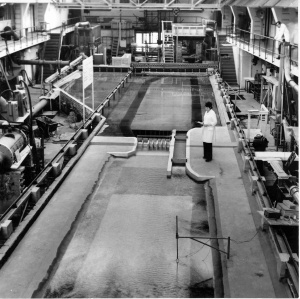
Hydrotechnical laboratory measurements
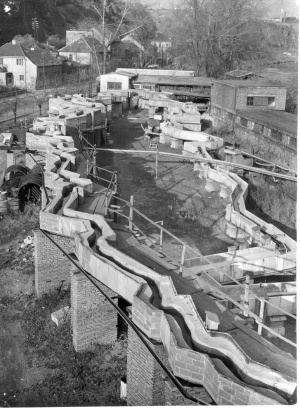
The model of the Vltava cascade constructed in WRI
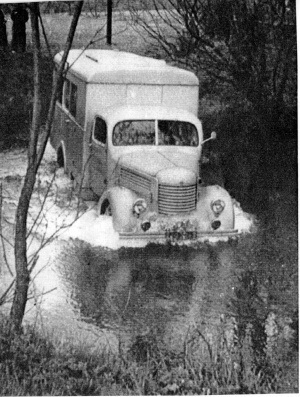 A mobile laboratory
A mobile laboratory
Development after 1989
After 1989, the Institute was transferred under the supervision of the newly established Ministry of the Environment of the Czech Republic as one of the first professional institutions oriented on individual elements of the environment. In 1992, concentration of all Prague workplaces into the premises in Podbaba was finished, and in 1993, the Institute became contributory institution of the Ministry of the Environment of the Czech Republic. In 1999, the Institute's activities were extended to waste management.
In August 2002, the Institute was affected by a devastating flood, whose consequences influenced its activities for almost three years. In spite of this fact, the professional activities of the Institute were not interrupted and its premises, computer networks, libraries and other assets were gradually restored. The restoration was highly facilitated by hard work of the staff and by help, involving financial contributions and gifts that were provided by the state, public and partner organizations, particularly from abroad. The situation was fully stabilized in 2005, when the activities of laboratories of water, waste and other environmental elements were launched in a new building in Prague-Podbaba and also adequate conditions were formed for other research activities.
Since 1st January 2007, the status of the Institute was changed to a public research institution by the Measure No. 12/2006 of the Ministry of the Environment of 12th December 2006, on the issue of the deed of foundation of the public research institution.
In June 2013, the Institute was again affected by the flood, which, although still far from catastrophic flood in 2002, but exceeded the 20-year flood. Its consequences were removed in several months.
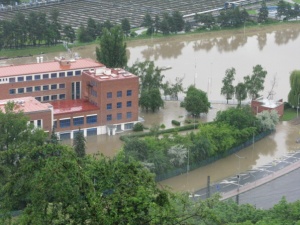
The Institute’s grounds affected by flood in 2013
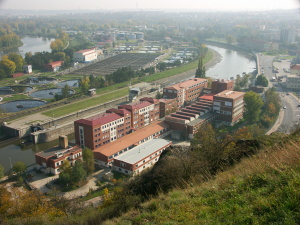
Current state of the Insitute´s Prague grounds
These new conditions did not substantially affect the research activities of the Institute, which are continuously focused on its main missions. The research projects include those focused on protection of river networks, water quality or assessments of water bodies, and large multidisciplinary projects, such as Research and protection of hydrosphere, Research on waste management, as well as projects for monitoring and evaluation of anthropogenic pressures on water quality in the basins of the Elbe, Odra and Morava Rivers. Of particular importance are also international cooperation and the professional activities aimed at supporting the public administration in specific areas, such as transposition and implementation of EU directives and associated reporting obligations, as well as the projects funded by several funding providers.



